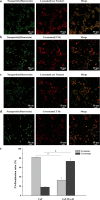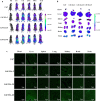Enhance transgene responses through improving cellular uptake and intracellular trafficking by bio-inspired non-viral vectors
- PMID: 32005170
- PMCID: PMC6995230
- DOI: 10.1186/s12951-020-0582-z
Enhance transgene responses through improving cellular uptake and intracellular trafficking by bio-inspired non-viral vectors
Abstract
Background: Gene therapy remains a significant challenge due to lots of barriers limiting the genetic manipulation technologies. As for non-viral delivery vectors, they often suffer insufficient performance due to inadequate cellular uptake and gene degradation in endosome or lysosome. The importance of overcoming these conserved intracellular barriers is increasing as the delivery of genetic cargo.
Results: A surface-functionalized non-viral vector involving the biomimetic mannitol moiety is initiated, which can control the cellular uptake and promote the caveolae-mediated pathway and intracellular trafficking, thus avoiding acidic and enzymatic lysosomal degradation of loaded gene internalized by clathrin-mediated pathway. Different degrees of mannitol moiety are anchored onto the surface of the nanoparticles to form bio-inspired non-viral vectors and CaP-MA-40 exhibits remarkably high stability, negligible toxicity, and significantly enhanced transgene expression both in vitro and in vivo.
Conclusions: This strategy highlights a paradigmatic approach to construct vectors that need precise intracellular delivery for innovative applications.
Keywords: Cellular uptake pathway; Intracellular trafficking; Non-viral vectors; Transgene.
Conflict of interest statement
The authors declare that they have no competing interests.
Figures






Similar articles
-
Construction and evaluation of BSA-CaP nanomaterials with enhanced transgene performance via biocorona-inspired caveolae-mediated endocytosis.Nanotechnology. 2018 Feb 23;29(8):085101. doi: 10.1088/1361-6528/aaa2b2. Nanotechnology. 2018. PMID: 29256442
-
Evaluation of cellular uptake and intracellular trafficking as determining factors of gene expression for amino acid-substituted gemini surfactant-based DNA nanoparticles.J Nanobiotechnology. 2012 Feb 1;10:7. doi: 10.1186/1477-3155-10-7. J Nanobiotechnology. 2012. PMID: 22296763 Free PMC article.
-
Protein kinase A inhibition modulates the intracellular routing of gene delivery vehicles in HeLa cells, leading to productive transfection.J Control Release. 2011 Nov 30;156(1):76-84. doi: 10.1016/j.jconrel.2011.07.015. Epub 2011 Jul 20. J Control Release. 2011. PMID: 21787817
-
Chemical vectors for gene delivery: uptake and intracellular trafficking.Curr Opin Biotechnol. 2010 Oct;21(5):640-5. doi: 10.1016/j.copbio.2010.07.003. Epub 2010 Jul 30. Curr Opin Biotechnol. 2010. PMID: 20674331 Review.
-
Octaarginine-modified liposomes: enhanced cellular uptake and controlled intracellular trafficking.Int J Pharm. 2008 Apr 16;354(1-2):39-48. doi: 10.1016/j.ijpharm.2007.12.003. Epub 2007 Dec 14. Int J Pharm. 2008. PMID: 18242018 Review.
Cited by
-
Nonviral nanoparticle gene delivery into the CNS for neurological disorders and brain cancer applications.Wiley Interdiscip Rev Nanomed Nanobiotechnol. 2023 Mar;15(2):e1853. doi: 10.1002/wnan.1853. Epub 2022 Oct 3. Wiley Interdiscip Rev Nanomed Nanobiotechnol. 2023. PMID: 36193561 Free PMC article. Review.
-
Functional Validation of the Putative Oncogenic Activity of PLAU.Biomedicines. 2022 Dec 30;11(1):102. doi: 10.3390/biomedicines11010102. Biomedicines. 2022. PMID: 36672610 Free PMC article.
-
Non-viral Vectors in Gene Therapy: Recent Development, Challenges, and Prospects.AAPS J. 2021 Jun 2;23(4):78. doi: 10.1208/s12248-021-00608-7. AAPS J. 2021. PMID: 34076797 Free PMC article. Review.
-
Unleashing the potential of mRNA: Overcoming delivery challenges with nanoparticles.Bioeng Transl Med. 2024 Aug 15;10(2):e10713. doi: 10.1002/btm2.10713. eCollection 2025 Mar. Bioeng Transl Med. 2024. PMID: 40060761 Free PMC article. Review.
-
Development of a Spray-Dried Formulation of Peptide-DNA Nanoparticles into a Dry Powder for Pulmonary Delivery Using Factorial Design.Pharm Res. 2022 Jun;39(6):1215-1232. doi: 10.1007/s11095-022-03256-4. Epub 2022 Apr 19. Pharm Res. 2022. PMID: 35441318 Free PMC article.
References
MeSH terms
Substances
Grants and funding
LinkOut - more resources
Full Text Sources
Research Materials
Miscellaneous

